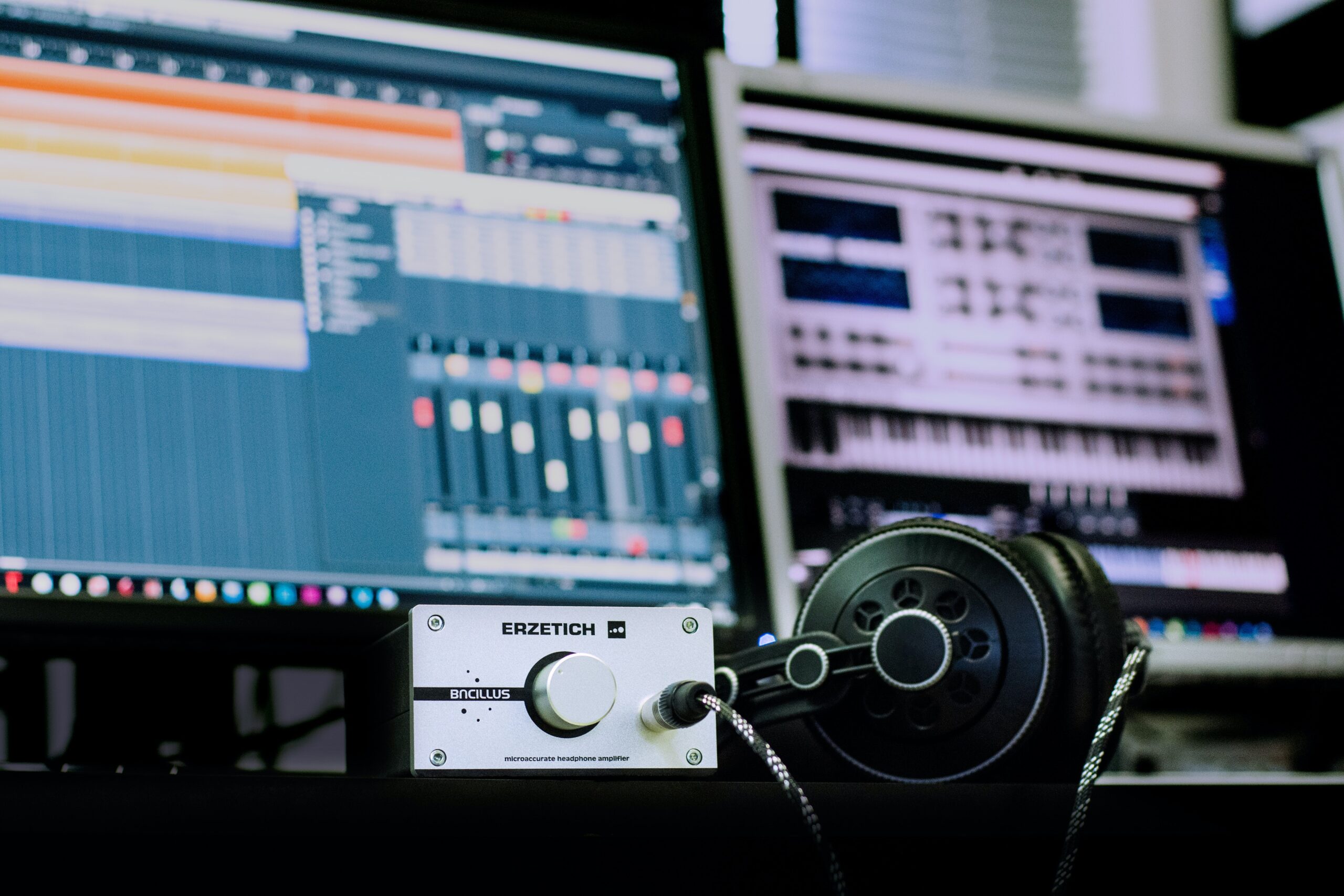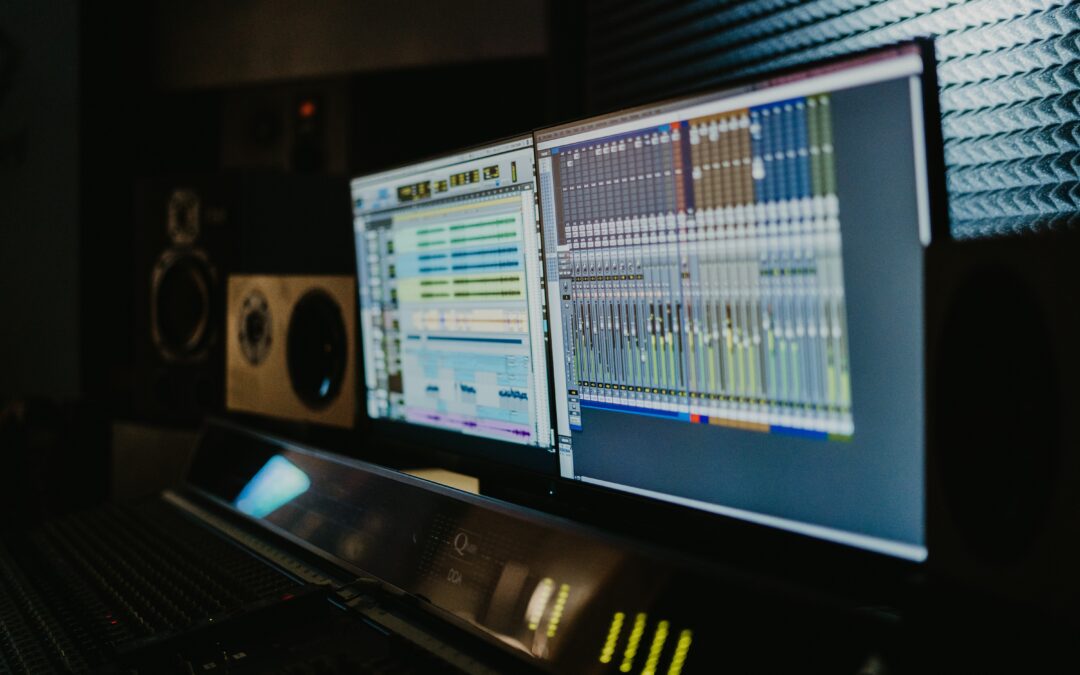I. Introduction
A. The Importance of Music Mastering in Music Production
Music Mastering is often referred to as the “final polish” in the music production process, and its significance cannot be overstated. While recording and mixing focus on capturing and shaping individual tracks, mastering takes a broader view, enhancing the overall sonic quality of an entire album or single track.
It’s the stage where professionals fine-tune the sound to meet industry standards and ensure it translates well to different playback systems, from home stereos to streaming platforms.
In an interview with Grammy-winning mastering engineer Bob Ludwig, he emphasizes that mastering is essential for making a track competitive in the market: “Music Mastering is the final chance to correct any problems in the mix and ensure the recording will translate well on all playback systems.” This makes it a crucial step for ensuring your music stands out in an oversaturated industry.
B. The Role of Music Mastering in the Modern Industry
The music industry has evolved significantly over the years, and mastering has evolved with it. With the advent of digital music distribution and streaming services, the importance of mastering has increased.
In an interview with Sound on Sound, mastering engineer Ian Shepherd explains how mastering for streaming platforms like Spotify and Apple Music has unique challenges: “Different streaming platforms have different loudness standards, which can affect how your music sounds.
Mastering engineers need to be aware of these standards to ensure your music sounds great on all platforms.”
Additionally, mastering plays a crucial role in maintaining consistency and coherence throughout an album.
Grammy-nominated mastering engineer Emily Lazar emphasizes this point: “Music Mastering is about making sure the entire album sounds cohesive and that no track sounds out of place.”
C. Overview of What to Expect in This Blog Post
In this comprehensive guide, we will cover a wide range of mastering techniques and practices, providing valuable insights from credible sources in the music industry.
We’ll explore everything from the basics of mastering to the advanced techniques that professional engineers use to elevate their work. By the end of this blog post, you’ll have a deeper understanding of mastering and the tools and skills necessary to produce high-quality music.
II. Understanding the Basics of Mastering
A. Defining Mastering in Music Production
Before we dive into the technical aspects, let’s define what mastering actually means in the context of music production. According to the Audio Engineering Society (AES), mastering is “the process of preparing and transferring recorded audio from a source to a data storage device.”
B. The Evolution of Mastering in the Digital Age
The history of mastering is closely intertwined with technological advancements in recording and playback equipment. In the early days of music production, mastering primarily involved transferring audio from analog tapes to vinyl records. Today, digital mastering tools and software have revolutionized the process.
Renowned mastering engineer Ted Jensen explains in an interview with Sound on Sound how digital technology has expanded the possibilities: “Digital mastering tools offer unprecedented precision and flexibility, allowing engineers to achieve sonic perfection.”
C. The Goals of Mastering: Clarity, Balance, and Cohesion
Mastering serves several key objectives, including:
- Clarity: Ensuring that every element of the mix is clear and distinct, from vocals to instruments.
- Balance: Achieving an ideal balance of frequencies and dynamics to create a pleasing listening experience.
- Cohesion: Making sure that all tracks on an album or EP sound consistent and flow seamlessly from one to the next.
To achieve these goals, mastering engineers employ a variety of techniques and tools.

III. Essential Tools and Equipment for Mastering
A. The Mastering Studio Setup
Setting up a dedicated mastering studio is crucial for achieving professional results. It’s not just about the gear; the room’s acoustics also play a significant role. According to an article by Sound on Sound, a well-designed studio should have accurate monitoring, high-quality analog and digital processors, and a treated listening environment to minimize reflections and resonance.
B. Choosing the Right Monitors and Acoustic Treatment
Selecting the right studio monitors and ensuring proper acoustic treatment are fundamental aspects of setting up a mastering studio.
Acoustic consultant and engineer Ethan Winer explains the importance of accurate monitoring: “Your studio monitors should provide an uncolored representation of the audio. You want to hear the music as it truly is, without any coloration or distortion.”
C. Hardware vs. Software: Pros and Cons
Mastering engineers have the choice between hardware and software processors. Each option has its advantages and disadvantages.
In an article for Pro Sound News, mastering engineer Bob Katz discusses the trade-offs: “Hardware processors often provide a tactile and intuitive interface, while software offers the convenience of recallable presets and greater flexibility.”
The choice between hardware and software often comes down to personal preference and workflow.
IV. Preparing Your Mix for Mastering
A. Mix Evaluation and Quality Control
Before sending your mix to a mastering engineer, it’s crucial to evaluate it thoroughly. This step involves checking for any issues that could be addressed in the mix, such as excessive noise, clicks, or phase problems. Grammy-winning engineer Michael Romanowski emphasizes the importance of quality control: “Fixing issues at the mixing stage is always preferable to trying to correct them in mastering.”
B. Proper Gain Staging and Headroom
Achieving the right level and headroom in your mix is essential for a successful mastering process. Audio engineer and educator Dave Pensado recommends leaving enough headroom: “Leaving some headroom allows the mastering engineer to apply necessary processing without causing distortion.”
C. Addressing Common Mix Issues
Mastering engineers often encounter common mix issues that need to be addressed. These can include imbalanced frequencies, harshness, or inconsistent dynamics. In an interview with Sound on Sound, mastering engineer Tony Cousins advises producers to address these issues during mixing: “A well-mixed track gives the mastering engineer more freedom to enhance rather than correct.”
In the next section, we’ll delve into specific mastering techniques, starting with the art of EQ.
Check out: Utilizing Sampling in Music Production
V. The Art of EQ in Mastering
A. Understanding EQ in Mastering
Equalization (EQ) is one of the most fundamental tools in mastering. It involves adjusting the balance of frequencies in a mix to achieve a desired tonal character. Renowned producer and engineer Sylvia Massy explains in an interview with Mix Magazine: “EQ can shape the overall sonic palette of a song, bringing out the best in each element.”
B. Corrective vs. Creative EQ
In mastering, EQ can be used both for corrective and creative purposes. Corrective EQ involves addressing imbalances or issues in the mix, while creative EQ allows for artistic tonal shaping. Producer and engineer Andrew Scheps highlights the importance of balance: “Mastering engineers often use EQ to make subtle but critical adjustments that enhance the listening experience.”
Techniques for Balancing Frequencies
Balancing frequencies is a delicate art, and there are various techniques mastering engineers use to achieve the desired tonal balance:
Broad Strokes: Starting with broad EQ adjustments to address overall tonal balance. Grammy-winning engineer Bob Katz suggests that “gentle adjustments to the low-end and high-end can have a significant impact.”
Mid-Side Processing: Mid-side EQ processing allows engineers to separately adjust the center and sides of the stereo image. This technique is useful for enhancing stereo width while maintaining a centered focus.
Dynamic EQ: Dynamic EQs respond to the dynamics of the audio, allowing for dynamic tonal shaping. This can be particularly useful for taming harsh frequencies that occur only during certain moments in the music.
Linear Phase EQ: Linear phase EQs maintain the phase relationship of frequencies, making them ideal for precise tonal adjustments without introducing phase issues.
VI. Dynamics Processing in Mastering
A. Compressors and Limiters: Their Role and Settings
Compressors and limiters are essential tools for controlling the dynamics of a mix during mastering. They help even out the levels and prevent distortion. According to an article by Sound on Sound, setting the right attack and release times on a compressor is crucial: “The attack time determines how quickly the compressor responds to transients, while the release time controls how long it takes for the compressor to stop attenuating.”
B. Multiband Compression and Dynamic EQ
Multiband compression and dynamic EQ go a step further by allowing engineers to target specific frequency ranges. This can be useful for taming resonant frequencies or controlling the dynamics of specific instruments. In an interview with MusicTech, mastering engineer Mandy Parnell discusses the power of multiband processing: “It offers precise control over problematic frequencies without affecting the entire mix.”
C. De-Essing and Saturation
De-essing is a technique used to reduce sibilance and harshness in vocals and instruments. It’s an essential tool in mastering to ensure a smooth listening experience. Additionally, subtle saturation can add warmth and character to a mix.
Grammy-nominated engineer Emily Lazar emphasizes the creative possibilities of saturation: “It can impart a pleasing analog-like warmth to digital recordings.”
VII. Stereo Imaging and Spatial Enhancement
A. Widening Your Mix: Stereo Imaging Techniques
Creating a spacious and immersive stereo image is a goal for many music producers. Stereo imaging techniques involve manipulating the stereo width of elements in the mix. Ethan Winer explains in his book, “The Audio Expert,” that “careful use of stereo wideners can make a mix sound more expansive.”
B. Panning and Mid-Side Processing
Panning is a fundamental aspect of stereo imaging. It involves placing audio elements in the stereo field to create a sense of space and dimension. Mid-side processing, as mentioned earlier, allows for precise control over the center and side elements of the stereo mix.
C. Achieving Depth and Space in Your Master
Depth and space are crucial for creating a three-dimensional listening experience. Reverb, delay, and ambience processing can be used to place instruments and vocals within a virtual space. In an article for SonicScoop, mix engineer Marc Urselli discusses the importance of spatial effects: “Careful use of reverb and delay can add depth and dimension to a mix, making it more immersive.”
VIII. Reference Tracks and Critical Listening
A. The Importance of Reference Tracks
Reference tracks are commercially released songs that serve as benchmarks for your own mixes and masters. They provide a point of comparison to ensure your music meets industry standards. Grammy-winning producer and engineer Frank Filipetti advises, “Always have a few reference tracks that you trust. They help you gauge how your music stacks up against professional productions.”
B. How to Select and Use Reference Tracks
Choosing the right reference tracks is crucial. They should be in a similar genre and style to your own music. When using reference tracks, compare them to your mix or master and take note of differences in tonal balance, dynamics, and spatial characteristics.
C. Developing Critical Listening Skills
Critical listening is a skill that takes time to develop. It involves actively listening to music with a discerning ear and identifying nuances in the mix and master. Music producer and educator Sylvia Massy suggests regular practice: “Train your ears by listening to a wide range of music and paying attention to details like EQ, dynamics, and spatial positioning.”
In the next section, we’ll explore how mastering techniques differ for various formats, including CDs, streaming, and vinyl.
IX. Music Mastering for Different Formats
A. CD Mastering vs. Streaming Mastering
Mastering for different formats requires consideration of their unique characteristics. CDs, for example, have specific technical requirements related to bit depth and sample rate. In contrast, streaming platforms like Spotify and Apple Music apply their own audio processing. Mastering engineer Ian Shepherd discusses the challenges of streaming mastering: “Streaming platforms use loudness normalization, which can affect the perceived loudness and dynamics of your music. Mastering for streaming requires careful consideration of these factors.”
B. Vinyl Mastering Considerations
Vinyl mastering is a specialized art. Vinyl records have their limitations, including limited dynamic range and the potential for surface noise. Renowned vinyl cutting engineer Bernie Grundman explains in an interview with Mix Magazine that vinyl mastering involves making adjustments to ensure the music translates well to the analog format: “Vinyl mastering requires careful attention to groove spacing, bass frequencies, and overall levels.”
C. Mastering for Film and Video Games
In addition to music, mastering also plays a crucial role in the audio production for film and video games. The requirements for these formats may differ significantly from music mastering. Audio post-production specialist Tim Nielsen highlights the importance of understanding the context: “Music Mastering for film and games involves ensuring that the audio fits seamlessly with the visuals. It’s about creating an immersive experience.”
X. The Role of Metadata and Delivery
A. Adding Metadata to Your Master
Metadata includes information about the song or album, such as song titles, artist names, album art, and copyright information. Properly embedded metadata ensures that your music is correctly identified when it’s played on various platforms. Music industry expert Bobby Owsinski stresses the importance of metadata: “Metadata is the digital fingerprint of your music. It helps ensure proper crediting and royalties.”
B. Preparing Files for Distribution
Before sending your mastered tracks to distributors or streaming platforms, you’ll need to prepare them correctly. This involves formatting your audio files, adding ISRC codes, and creating high-quality digital masters. Music distribution service DistroKid provides guidelines for preparing files for distribution to ensure your music is delivered correctly.
C. Common File Formats and Bit Rates
Different platforms may have specific requirements for file formats and bit rates. For example, WAV and FLAC are common formats for high-quality audio, while MP3 is a widely used compressed format. Understanding these requirements is essential for delivering your music in the best possible quality.
Check out: Live Sound Engineering for Music Producers
XI. Continual Learning and Professional Development
A. Staying Updated with Industry Trends
The music production industry is constantly evolving. Staying informed about the latest trends, technologies, and techniques is essential for mastering engineers and music producers alike. Grammy-nominated engineer Emily Lazar emphasizes the need for ongoing learning: “The music industry is ever-changing. It’s crucial to adapt and embrace new tools and methodologies to stay competitive.”
B. Networking and Collaboration Opportunities
Networking within the music industry can open doors to collaboration and professional growth. Music producer and composer Quincy Jones once said, “Networking is not about just connecting people. It’s about connecting people with people, people with ideas, and people with opportunities.” Engaging with other musicians, producers, and mastering engineers can lead to valuable collaborations and learning experiences.
C. Resources for Further Learning and Skill Enhancement
There is a wealth of resources available for those looking to further their knowledge and skills in mastering:
Online Courses: Platforms like Coursera, Udemy, and Berklee Online offer courses on mastering and audio production.
Books: Literature such as “Mastering Audio” by Bob Katz and “The Mastering Engineer’s Handbook” by Bobby Owsinski provide in-depth insights into mastering techniques.
Mastering Forums: Online forums and communities like Gearslutz and the Mastering World forums are excellent places to exchange knowledge and learn from experienced mastering engineers.
Seminars and Workshops: Attend workshops and seminars hosted by industry professionals to gain hands-on experience and valuable insights.
Mentorship: Seeking mentorship from an experienced mastering engineer can be a transformative learning experience.
XII. Conclusion
In this extensive guide, we’ve explored the art and science of mastering techniques for music producers. From understanding the basics of mastering to delving into EQ, dynamics processing, stereo imaging, and mastering for various formats, you now have a comprehensive understanding of the mastering process.
Mastering is not just a technical endeavor; it’s an art that requires a finely tuned ear, attention to detail, and a commitment to continual learning. As you embark on your mastering journey, remember that perfection is an ongoing pursuit, and each track you work on is an opportunity to refine your craft.
In the ever-evolving landscape of the music industry, mastering remains a critical step in ensuring your music reaches its full potential and stands out in a crowded market. By applying the techniques and principles discussed in this guide, you’ll be well on your way to mastering the art of mastering and producing music that captivates and resonates with audiences worldwide.
So, go ahead, unleash your creativity, and let your music shine. Mastering is your final canvas, where the finishing touches transform a great track into a masterpiece. The journey of mastering is not just about reaching the destination but enjoying every step of the process. Happy mastering!






